The clock strikes 9 AM on a crisp Monday morning. You settle into your favorite chair, ready to start a new web project. You’ve been using Node for most of your projects, but now this “Bun” thing has come along.
So you’re sitting there, wondering, “Should I go with my tried-and-trusted Node.js or give Bun a try?”
While this question may seem simple, it will influence your project’s performance and potentially your team’s workflow for months to come.
And you’re not alone in this dilemma.
But what exactly sets these two apart? How do they compare in terms of features and performance? Most importantly, which one should you choose for your project?
In this article, we’ll explore these questions and compare Node.js and Bun across various dimensions. Our goal? To equip you with the knowledge required to make an informed decision that aligns with your project’s needs, team expertise, and long-term objectives.
But first — for your article-reading-listening pleasure…
Okay, now we’re ready. Let’s take a look at each runtime briefly.
What Is Node.js?
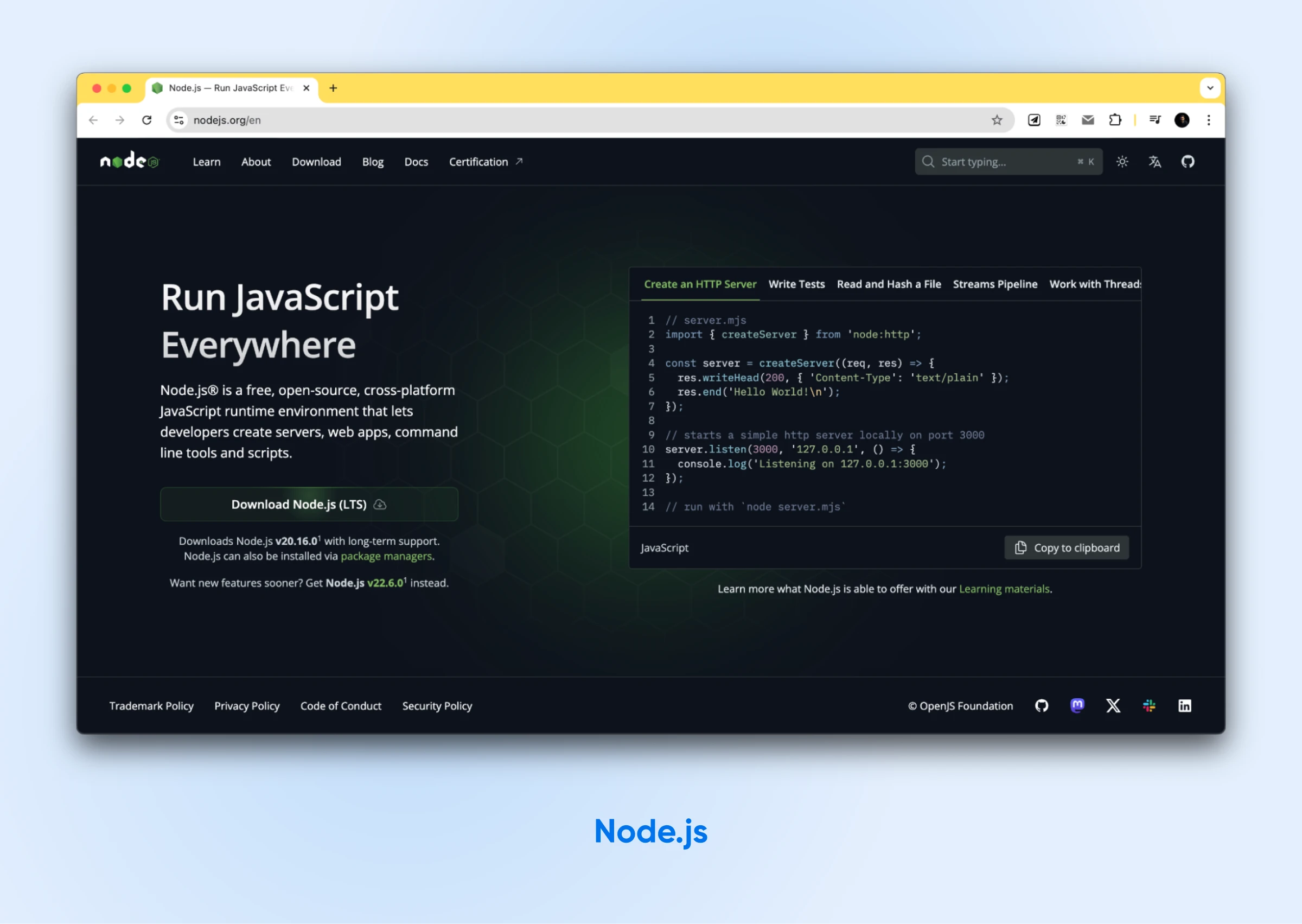
Node.js, first released in 2009 by Ryan Dahl, changed server-side JavaScript.
It allowed developers to use JS outside the browser, opening up new possibilities for building scalable network applications.
Node.js runs on the V8 JavaScript Engine, the same engine that powers Google Chrome. Its event-driven, non-blocking I/O model is well-suited for building fast, scalable network applications.
Key features of Node.js include:
- A mature ecosystem with millions of packages available through npm (Node Package Manager).
- Great performance for synchronous tasks.
- Strong community support and extensive documentation.
- Wide adoption in enterprise environments.
What Is Bun?
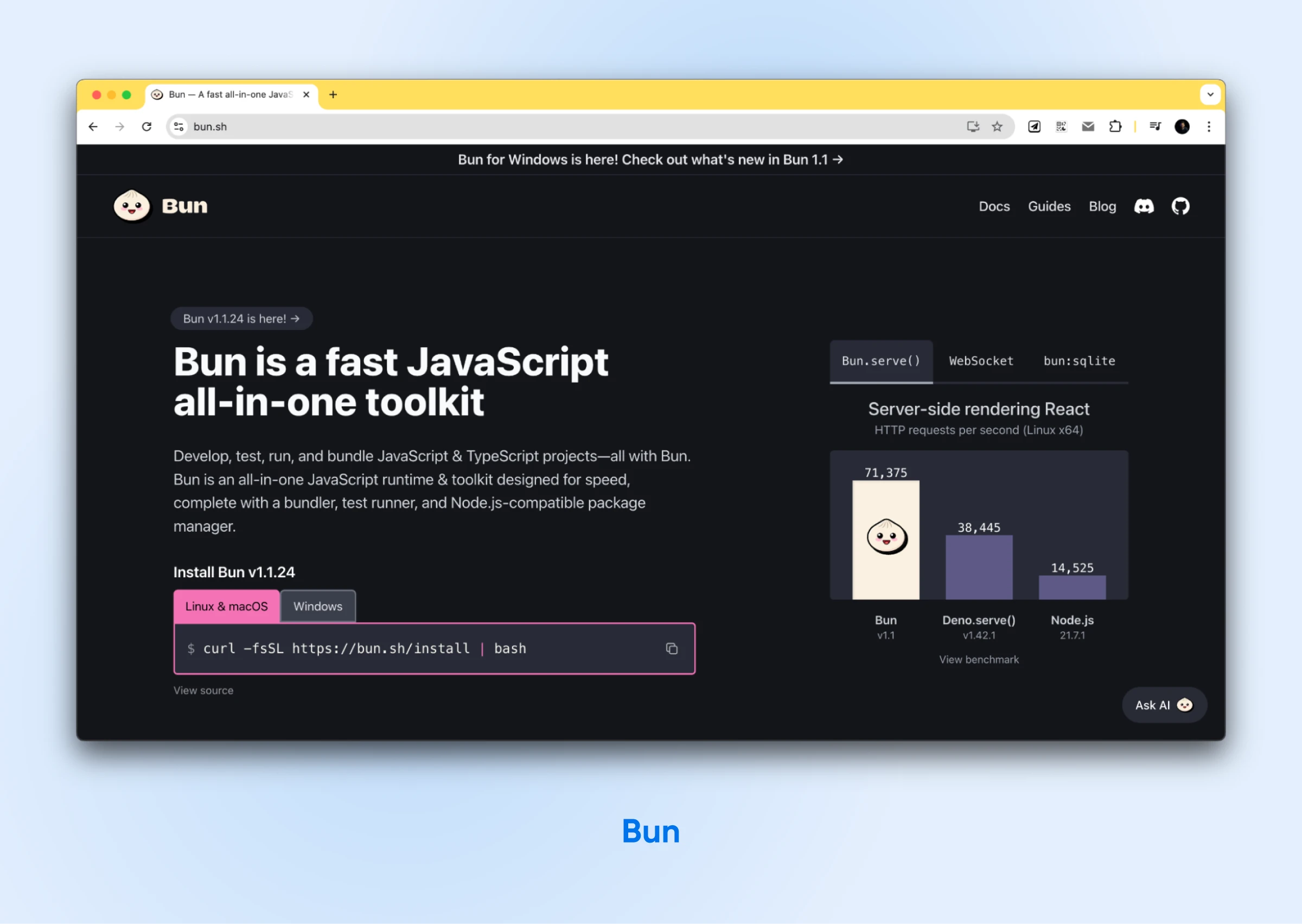
Bun is the new kid on the block.
Released in 2022 by Jarred Sumner, Bun positions itself as a drop-in replacement for Node.js, promising faster performance and an improved developer experience.
Bun is written in Zig, a low-level programming language, and uses the JavaScriptCore engine (the same engine used in Safari) instead of V8. This means it runs much closer to your hardware than Node, resulting in faster-performing apps. We’ll look at this in a bit.
Key features of Bun include:
- All-in-one toolkit — runtime, package manager, bundler, and test runner.
- Native TypeScript support without additional setup.
- Faster startup times and improved performance for many operations.
- Growing ecosystem and community.
Bun vs. Node.js: Performance Comparison
Let’s dive into the most talked-about aspects when comparing Bun vs. Node.js: performance.
We’ll look at some benchmark results from 5ly and an independent developer here.
1. CPU-Intensive Tasks
For CPU-bound operations, Bun shows impressive performance gains over Node.js. This first test involved generating and sorting 100,000 random numbers 10 times consecutively.
These were the results:
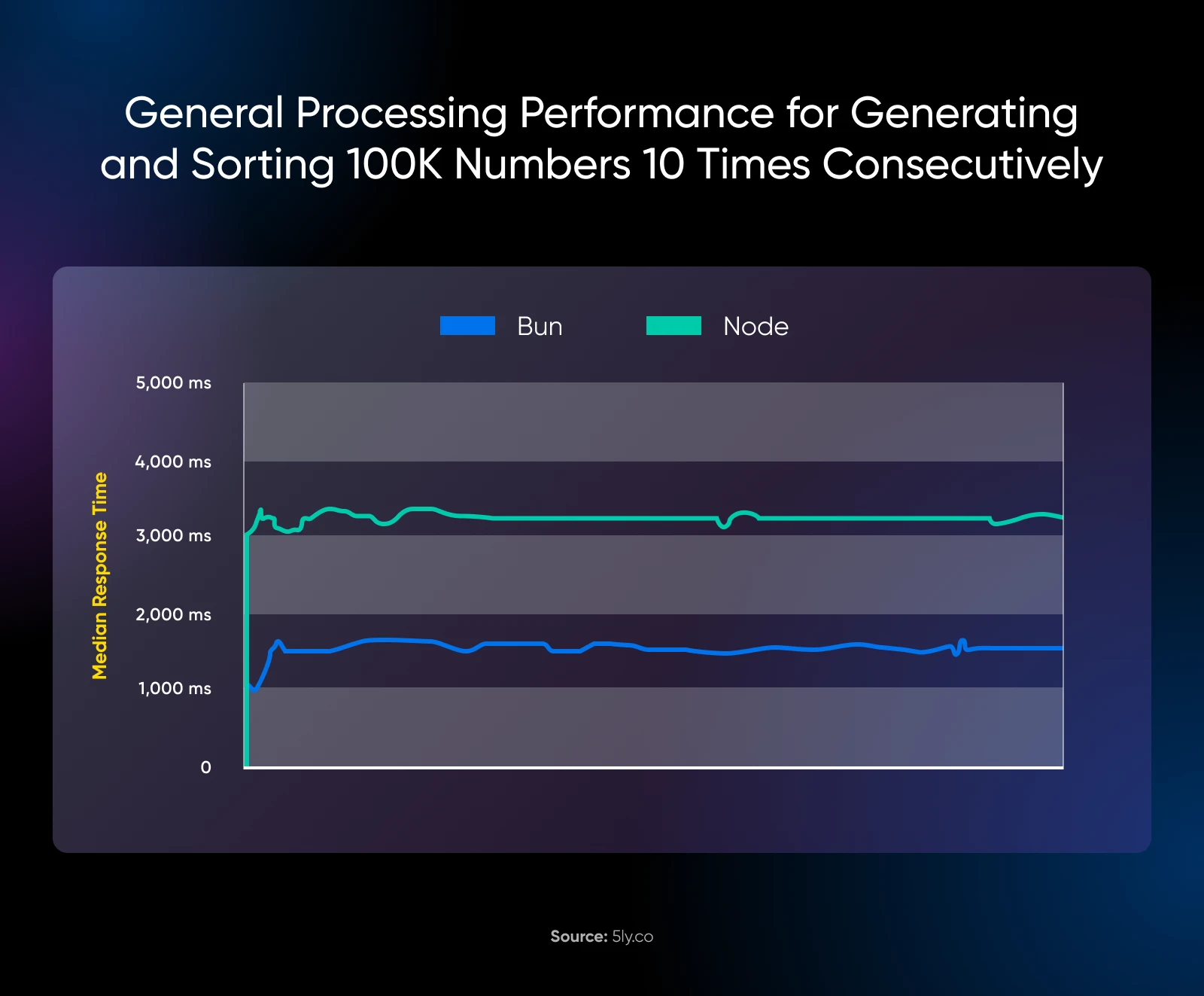
- Node.js: 3400 ms (median response time)
- Bun: 1700 ms (median response time)
Bun completed the task in half the time of Node.js, which demonstrates its efficiency in handling CPU-intensive workloads. This performance advantage could be significant for applications that involve heavy computation or data processing.
2. CRUD API Operations
When it comes to typical CRUD (Create, Read, Update, Delete) operations, which are common in many web applications, the difference in performance is less pronounced.
The following were the results of running these CRUD operations with DynamoDB:
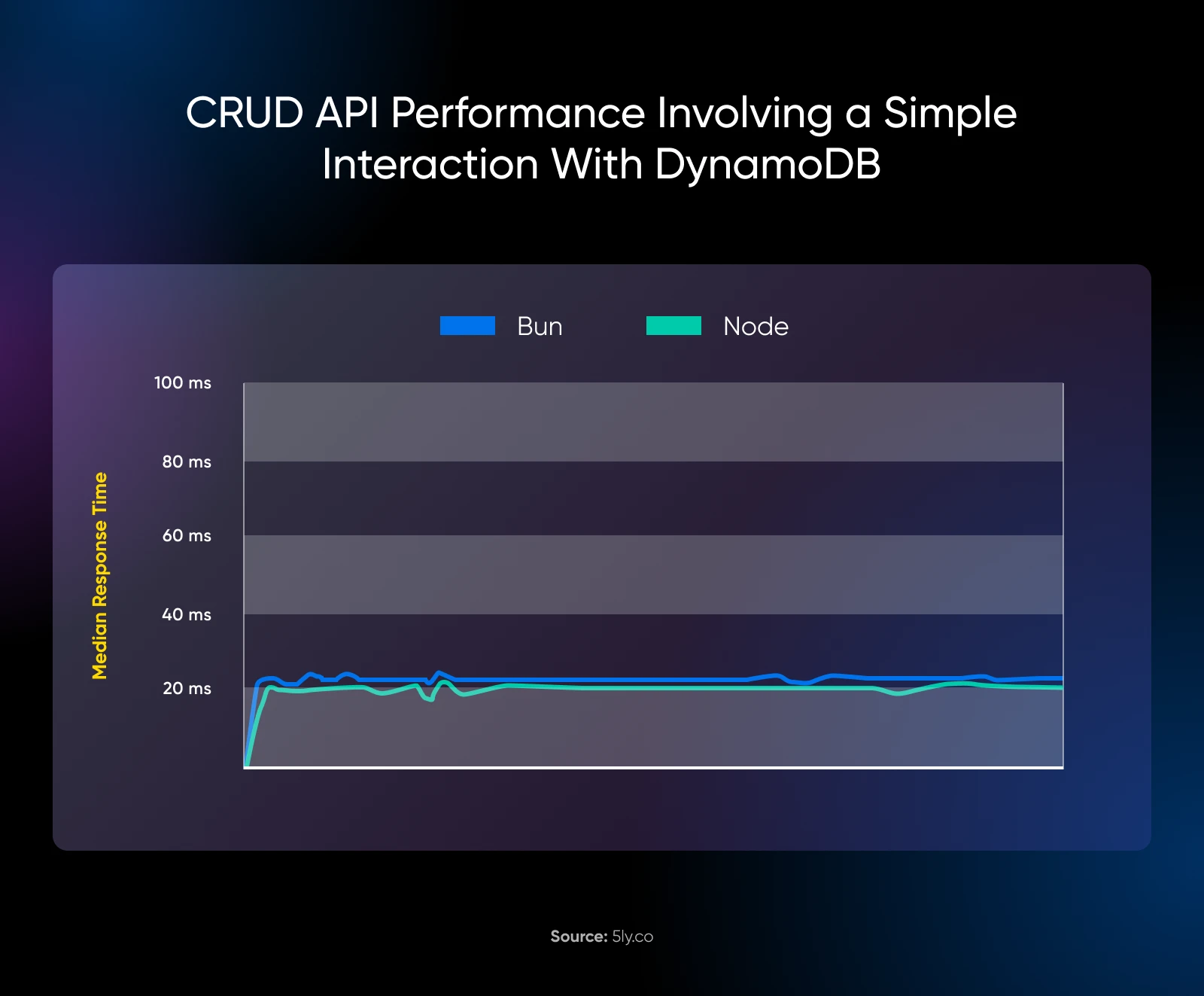
- Node.js: 22 ms (median response time)
- Bun: 23 ms (median response time)
Here, Bun’s performance was very close to Node.js, with just a 4.5% difference. If you’re using a different database like MySQL or PostgreSQL, the results may differ. However, we haven’t tested the results on these databases.
Database
A database is a collection of information accessible to computers. Databases are used to store information such as customer records, product catalogs, and financial transactions.
Read More3. Cold Start Times
Cold start times are particularly important for serverless environments, where functions may need to initialize frequently.
A test executing a “Hello World” function with induced cold starts revealed:
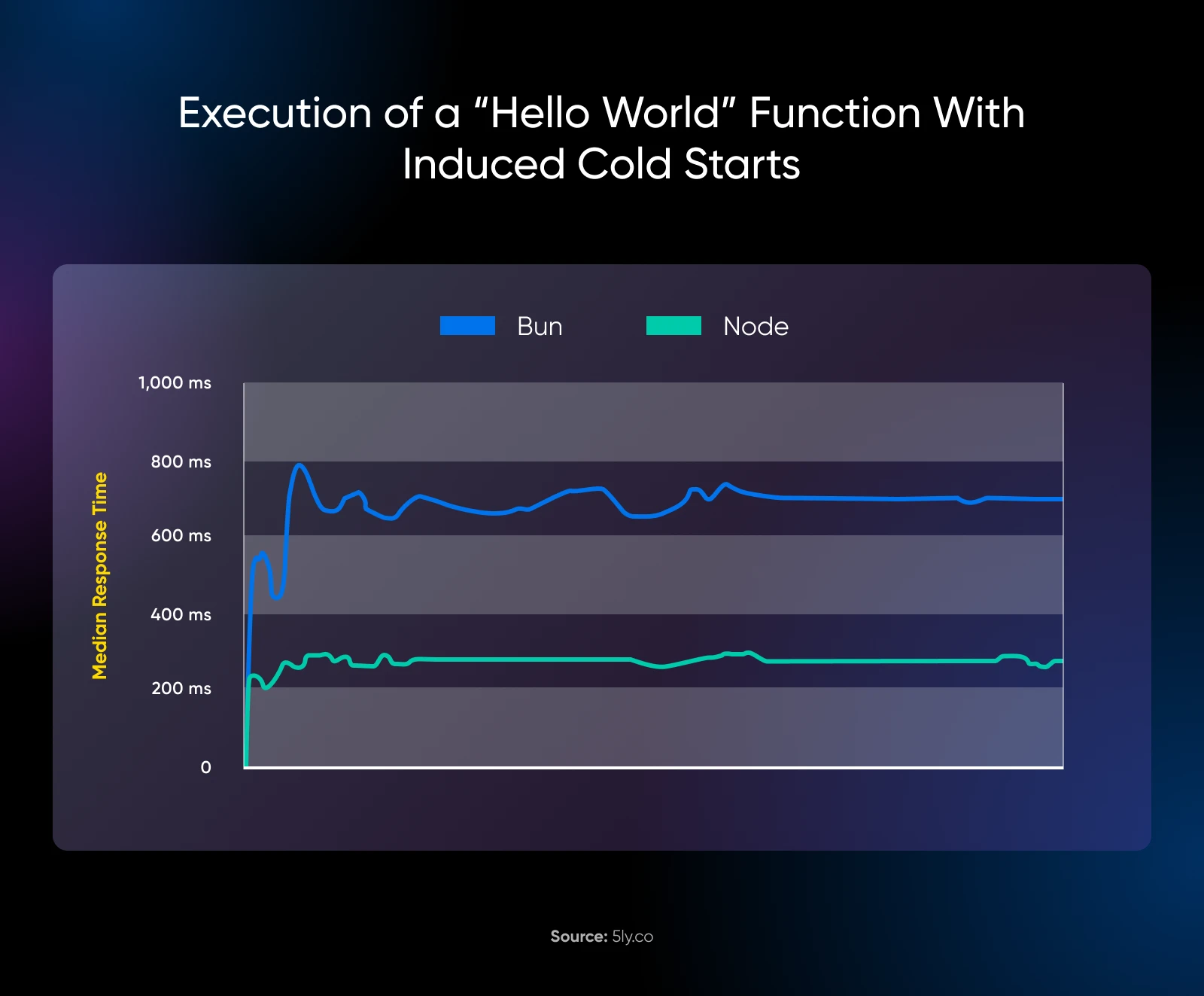
- Node.js: 290 ms (median response time)
- Bun: 750 ms (median response time)
Surprisingly, Bun currently has significantly longer cold start times compared to Node.js. This could be a disadvantage in serverless environments where quick startup times are crucial.
It’s an area where Bun may need improvement to compete effectively with Node.js in serverless scenarios.
4. Memory Usage
Efficient memory usage is important for scalability and resource management.
Monitoring memory consumption during CRUD operations showed:
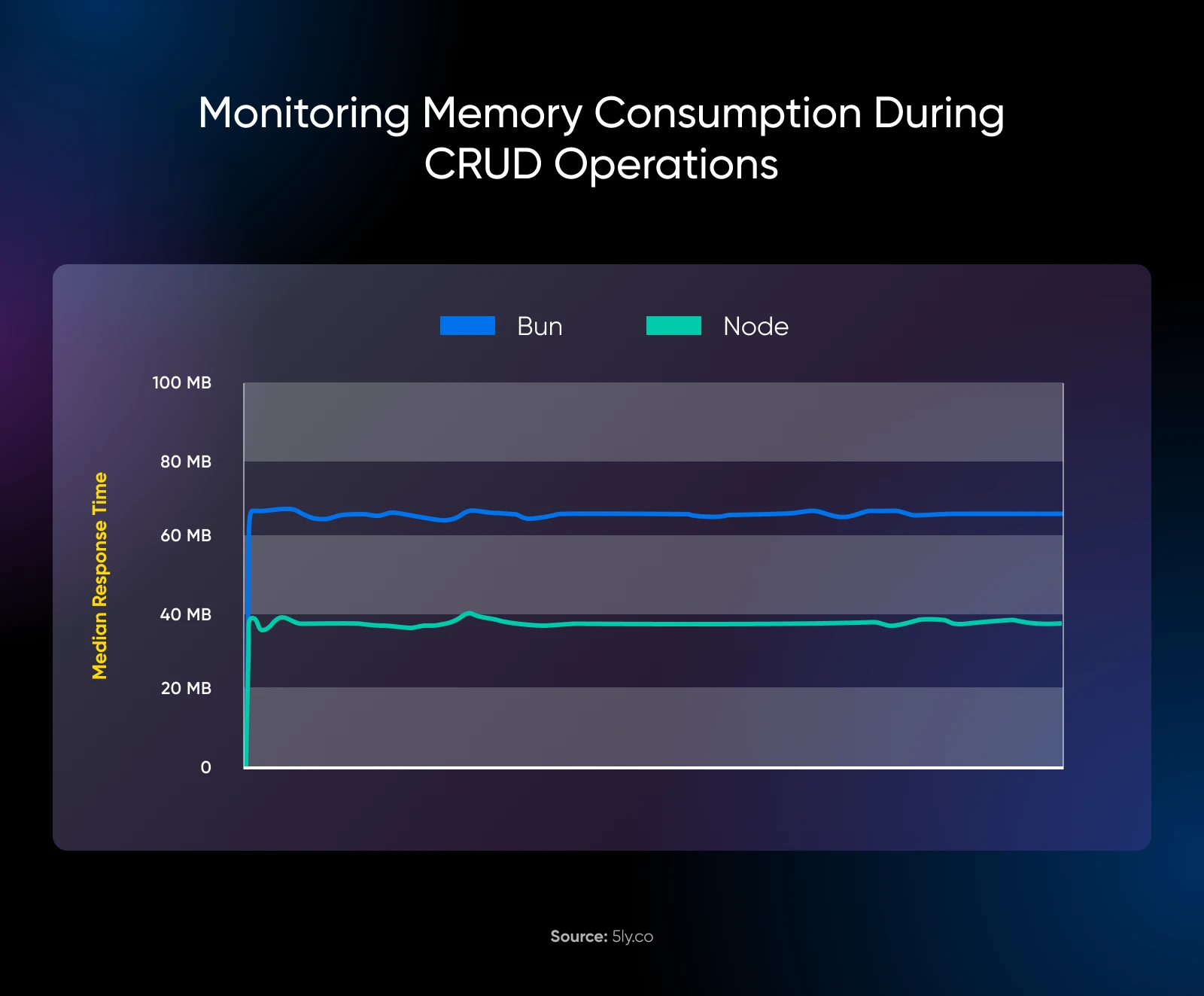
- Node.js: 40 MB (average memory used)
- Bun: 70 MB (average memory used)
Bun currently uses more memory than Node.js, which could be a concern for memory-constrained environments or when running many instances of an application. This higher memory usage might be a trade-off for Bun’s performance improvements in other areas.
5. HTTP Server Performance
Bun claims to outperform both Node.js and Deno in HTTP server performance:
Bun.serve(): Outperforms Node.js by 377% and Deno by 102%
These are impressive numbers, suggesting that Bun could be particularly well-suited for building high-performance web servers. However, note that these benchmarks are a result of a small set of tests.
The best way to gauge the performance differences is to actually perform similar tests on your customized setup to determine if switching to Bun makes a significant difference in your app performance.
Server
A server is a computer that stores data. A web server is a type of server that stores web page data and then sends these web pages to users who request them over the internet.
Read MoreNode vs. Bun: How Do the Features Compare?
Now that we’ve covered the performance differences, let’s also look at the differences in features so you can decide which out of the two would be good for you.
| Feature | Node.js | Bun |
| First release | 2009 | 2022 |
| JavaScript Engine | V8 | JavaScriptCore |
| Package manager | npm (separate) | Built-in |
| TypeScript support | Requires setup | Native |
| Bundler | Requires external tools | Built-in |
| Test runner | Requires external tools | Built-in |
| Ecosystem size | Very large | Growing |
| Production readiness | Battle-tested | Maturing |
1. Package Management
One of the first things you’ll interact with when starting a new project is the package manager. Node.js and Bun take different approaches here.
Node.js relies on npm as its primary package manager. At this point, npm comes bundled with Node.js installations and has been the go-to solution for JavaScript developers for years. It’s powerful, widely adopted, and has a vast registry of packages.
However, npm can sometimes be slow, especially for large projects with a lot of dependencies.
Bun, on the other hand, includes a built-in package manager that is significantly faster than npm.
Here’s a performance benchmark of the Bun package manager vs. pnpm, npm, and Yarn.
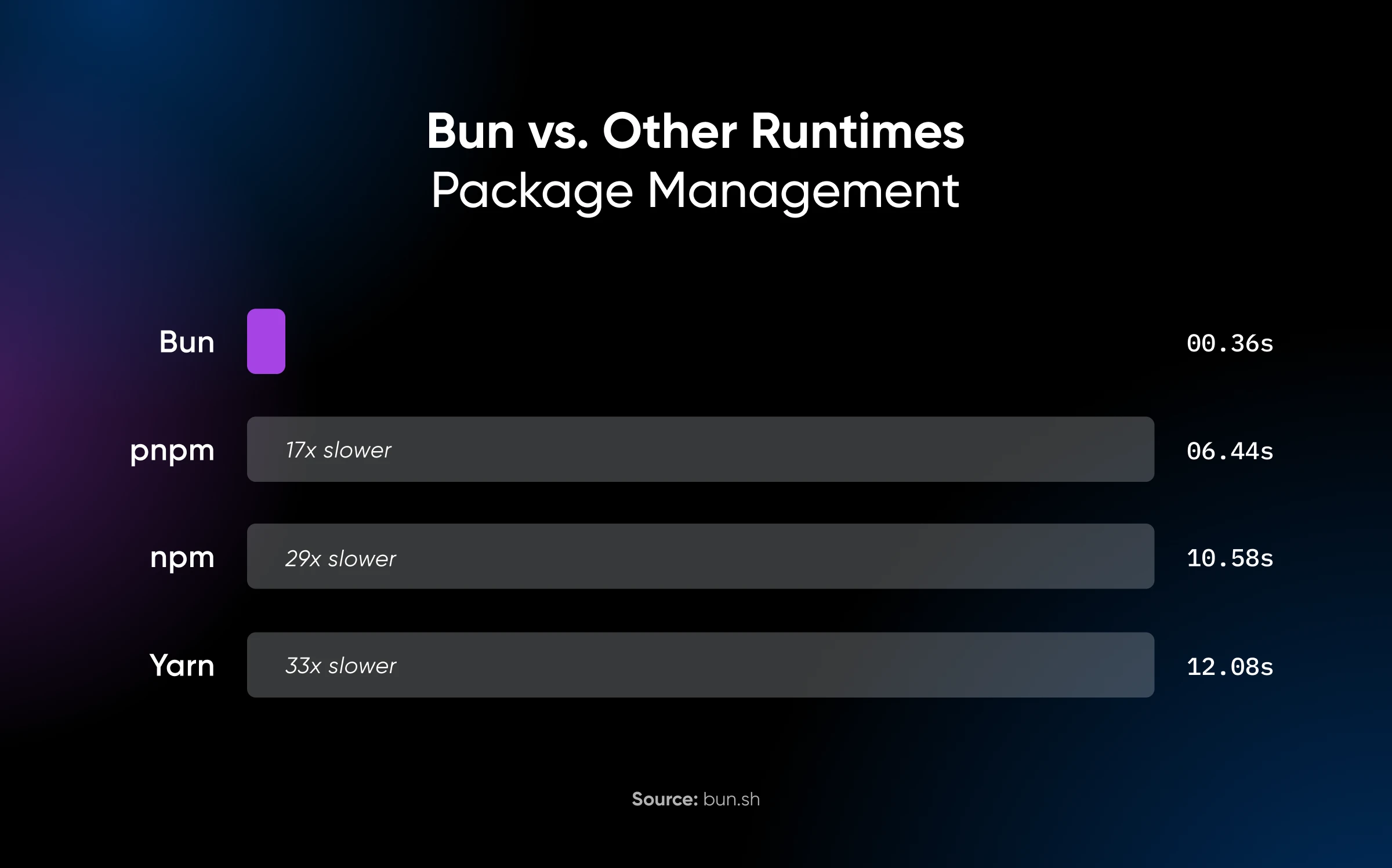
It can use existing package.json files and node_modules directories, making it easier to transition existing projects. Bun’s package manager is designed to be compatible with npm, allowing you to use most npm packages without issues.
The built-in Bun package manager means you don’t need to install or configure a separate tool and can simplify your development setup, potentially speeding up your workflow.
2. TypeScript Support
TypeScript has become increasingly popular in recent years, offering static typing and improved tooling for JavaScript developers. The level of TypeScript support differs significantly between Node.js and Bun.
Node.js just recently (July 2024) added experimental TypeScript (TS) support. It’s not production-ready yet, and if your project needs TS support, you typically need to set up additional tools like ts-node or add a compilation step to your workflow. While people believe this will change over time, as of this writing, we still need to work with ts-node.
Bun, however, offers native TypeScript support out of the box. You can run .ts files directly without any additional configuration. This seamless TypeScript integration can be a significant time-saver and reduce the complexity of your project setup.
If you’re starting a new project that needs TypeScript now or you plan to add TypeScript code in the future, Bun could be a good overall choice here.
However, since Node.js has already added experimental support for TypeScript, it may not take long for Node to catch up — except for the performance differences.
3. Bundling
Developers use a “bundler” to reorganize and consolidate code from multiple files into fewer files. This is generally done to simplify deployment and efficiently manage dependencies.
Node.js doesn’t come with a built-in bundler. Instead, developers typically use external tools like Webpack, Rollup, or Parcel for bundling their applications. While these tools are powerful and flexible, they require additional setup and configuration, which can add complexity to your project.
Bun, staying true to its all-in-one philosophy, includes a built-in bundler. The integrated bundler aims to simplify the development workflow by eliminating the need for separate bundling tools. It’s designed to be fast and efficient, potentially reducing build times compared to traditional bundlers.
4. File Input/Output (I/O) Operations
File I/O operations are common tasks in many applications, from reading configuration files to processing large datasets. You want a runtime that’s efficient and does I/O as seamlessly as possible.
Node.js offers a comprehensive set of APIs for file I/O operations through its fs (file system) module. These APIs are well-documented, widely used, and provide both synchronous and asynchronous methods for file operations. Node.js’s event-driven architecture makes it particularly well-suited for handling I/O-bound tasks efficiently.
Bun also provides APIs for file I/O operations, and it claims to offer faster performance in this area compared to Node.js. Bun’s file I/O APIs are designed to be largely compatible with Node.js, making it easier to port existing code.
The potential performance improvements in file I/O operations could be significant for applications that deal with frequent file reads and writes, such as build tools, static site generators, or data processing scripts.
5. API Compatibility
Switching runtimes or frameworks isn’t the easiest job for a developer. You need to consider how much of your existing codebase needs to change. That’s the same case for switching between Node.js and Bun.
Node.js has a well-defined and stable API that developers have relied on for years. It includes core modules for tasks like file system operations, networking, cryptography, and more. The stability and completeness of the Node.js API are one of its strong points.
Bun aims for a high degree of compatibility with Node.js APIs. Many core Node.js modules and APIs work out of the box with Bun. Apart from the existing ones, Bun has many web standard APIs, which can make it easier to write code that works both in the browser and on the server.
However, even if Bun is compatible with Node.js APIs, it may not support everything you have already coded in Node. Some more nuanced use cases of Node in your project may require more work transitioning to Bun.
6. Ecosystem and Community
The ecosystem and community surrounding a runtime can be just as important as its technical features.
The thing is, there are thousands of people coding every day, solving new problems, creating reusable packages for the solutions, and sharing them with the community. You don’t need to code everything from scratch every time.
Instead, a strong ecosystem and community give you access to these pre-made solutions, so you can simply put the pieces of the puzzle together and complete your code.
How do Node.js and Bun compare in this aspect, then? Let’s check it out.
Node.js boasts a vast ecosystem with millions of packages available through npm. Whatever functionality you need, chances are there’s already a package for it. This rich ecosystem can significantly speed up development by allowing you to leverage existing solutions instead of building everything from scratch.
Node.js also has a large, established community.
This means abundant resources, tutorials, blog posts, and third-party tools. If you encounter a problem, it’s likely that someone else has already solved it and shared the solution.
Bun, being newer, has a smaller but rapidly growing ecosystem and community. While it can use most npm packages, which helps bridge the gap, there may be fewer Bun-specific packages and resources available.
The community is active and enthusiastic, but it’s not yet as large or established as the Node.js community.
However, Bun’s growing community brings fresh energy and ideas to the JavaScript ecosystem. As an early adopter, you have the opportunity to shape the future of the platform and contribute to its growth.
When to Choose Bun
Bun’s performance advantages and modern features make it well-suited for certain types of projects:
- CPU-intensive applications: Bun’s performance advantages could be significant if your application involves heavy computation or data processing. Think of tasks like data analysis, machine learning, or complex calculations.
- TypeScript-heavy projects: The native TypeScript support can streamline development for TypeScript-centric applications, potentially improving developer productivity and reducing build complexity.
- Quick prototyping: The built-in, all-in-one toolkit can help you get projects up and running quickly with less configuration. This could be particularly useful for hackathons, proof-of-concept projects, or rapid prototyping scenarios.
- Performance-critical microservices: For microservices where every millisecond counts, Bun’s speed improvements could be beneficial. This could apply to high-traffic APIs or services that need to handle a large number of requests quickly.
- Developer tools: Bun’s faster execution times could improve the experience for CLI tools and build scripts, potentially speeding up development workflows.
When to Choose Node.js
Node.js remains the go-to choice for many JavaScript projects due to its maturity, stability, and ecosystem:
- Large-scale enterprise applications: Node.js’s proven track record and extensive ecosystem make it a safer choice for critical enterprise systems where stability and long-term support are crucial.
- Projects with complex dependencies: If your application relies on a wide range of npm packages, Node.js ensures maximum compatibility and stability. This is particularly important for large, complex applications with many interdependent parts.
- Serverless functions: Node.js’s faster cold start times make it more suitable for serverless environments where functions need to spin up quickly in response to events.
- Memory-constrained environments: Node.js’s lower memory footprint could be advantageous in environments with limited resources, such as small cloud instances or containerized deployments where memory is at a premium.
- For teams with deep Node.js expertise: If your team is already highly proficient with Node.js, the productivity gains from familiarity might outweigh Bun’s performance benefits—at least in the short term.
So, Bun vs. Node: What’s Your Choice?
You’ve made it through the Node.js vs. Bun comparison, and now you’re wondering which runtime you’ll choose for your next project.
The seasoned veteran Node.js, or the energetic newcomer, Bun?
We hate to say it, but there’s no “right” answer. Your perfect match depends on your project’s unique needs, your team’s skills, and your appetite for adventure.
Node.js is like that comfy old sweater you’ve had for years. It’s reliable, familiar, and gets the job done. You know its quirks, and it knows yours. If you want a solid foundation with tons of packages at your fingertips, Node.js has your back.
And Bun? It’s the shiny new gadget that promises to make your life easier. It’s fast, it’s sleek, and it’s got some tricks up its sleeve. If you’re the type who loves to try the latest and greatest, Bun might be right up your alley.
So, why not take Bun for a spin on a small project? See how it handles your usual tasks. You might just find some use for it in your upcoming projects.
Oh, and don’t forget about finding a good home for your code. DreamHost’s VPS hosting works seamlessly with both Node.js and Bun. It’s the perfect place for testing and deploying your app!

Take Charge with Flexible VPS Hosting
Here’s how DreamHost’s VPS offering stands apart: 24/7 customer support, an intuitive panel, scalable RAM, unlimited bandwidth, unlimited hosting domains, and SSD storage.
Choose Your VPS Plan
